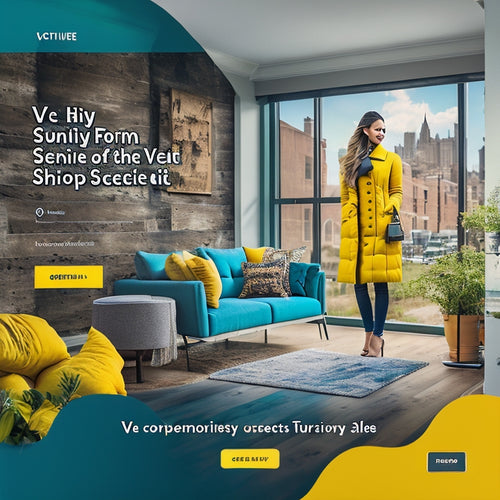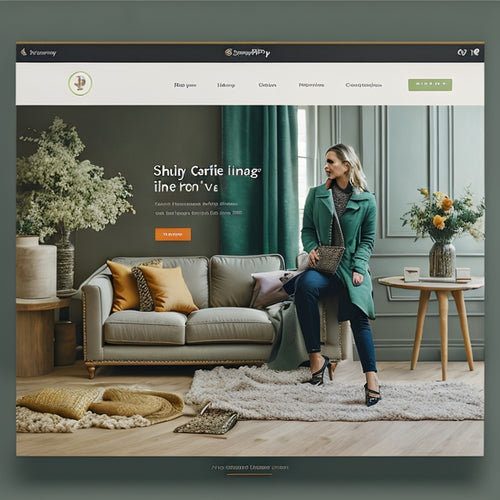
Boosting Customer Loyalty With Digital Products
Share
You're sitting on a goldmine of customer data, and by harnessing the power of digital products, you can uncover the hidden patterns and preferences that drive loyalty and retention. Leverage analytics to track product performance, gain granular insights into customer behavior, and inform development strategies. Measure engagement metrics like session duration and feature adoption to understand customer interactions. Identify pain points and gaps through experience gap mapping and prioritize areas for improvement based on customer feedback. By personalizing experiences and building strong relationships through support, you'll drive long-term loyalty. Now, discover how to turn these insights into actionable strategies that propel customer loyalty forward.
Key Takeaways
• Analyze customer behavior through analytics tools to identify pain points and areas for improvement in digital products.
• Develop personalized experiences based on individual preferences to increase engagement and loyalty.
• Implement data-driven retention strategies to address customer pain points and reduce churn.
• Create seamless omni-channel experiences that integrate social media, email, and in-app promotions for consistent branding and messaging.
• Foster emotional connections through memorable experiences and regular collection of customer feedback to show value and drive loyalty.
Understanding Digital Product Analytics
Track your digital product's performance by leveraging analytics tools that provide granular insights into customer behavior, preferences, and pain points. You'll gain a deeper understanding of how users interact with your product, identifying areas of friction and opportunities for improvement.
Data visualization tools will help you make sense of complex data sets, presenting findings in a clear, actionable way. By analyzing user behavior, you'll uncover patterns and trends that inform product development and optimization strategies.
For instance, you might discover that users are dropping off at a specific stage in your onboarding process, or that certain features are underutilized. Armed with this knowledge, you can refine your product to better meet customer needs, driving loyalty and retention.
Don't just rely on intuition – let data-driven insights guide your decision-making. By doing so, you'll create a digital product that truly resonates with your target audience, setting you apart from competitors and driving long-term success.
Measuring Customer Engagement Metrics
By monitoring key customer engagement metrics, such as login frequency, time spent on the platform, and feature adoption rates, you can gauge the depth of your customers' emotional investment in your digital product. This is important in understanding how to improve interactions and foster loyalty.
To get a detailed view, you should track the following metrics:
-
Session duration and frequency: How often do customers log in, and how long do they stay?
-
Feature adoption rates: Which features are being used, and which ones are being neglected?
-
Bounce rates: Are customers leaving your platform immediately, or are they engaging with your content?
- Net Promoter Score (NPS): How likely are customers to recommend your digital product to others?
Identifying Pain Points and Gaps
When analyzing customer feedback and behavior, you're likely to uncover unmet needs that can be addressed with targeted digital products.
By conducting an experience gap mapping exercise, you'll identify specific areas where your offerings fall short of customer expectations.
Unmet Needs Analysis
What're the specific pain points and gaps in your customers' experiences that your digital products can address, and how can you identify them through a rigorous unmet needs analysis?
To enhance customer satisfaction, you must first understand their frustrations and unmet expectations. Conducting market research through surveys, focus groups, and customer feedback sessions can help you identify areas of improvement.
Here are 4 key areas to focus on:
-
Service quality: Are your customers satisfied with the level of support they receive?
-
Product features: Are there specific features or functionalities that your customers feel are missing?
-
User experience: Are your customers struggling to navigate your digital products or find the information they need?
- Personalization: Are your customers feeling like they're receiving a tailored experience that meets their individual needs?
Experience Gap Mapping
You can visualize the pain points and gaps in your customers' experiences by creating an experience gap map, a strategic tool that helps you identify and prioritize areas for improvement.
This map is a visual representation of your customers' journeys, highlighting the disparities between their expectations and the actual experiences they've with your digital products. By analyzing customer feedback and satisfaction metrics, you can pinpoint the moments of friction, confusion, and frustration that drive customers away.
Through experience gap mapping, you'll uncover opportunities to enhance customer satisfaction by addressing these pain points. For instance, you might identify a gap in onboarding support, leading to high bounce rates. By implementing a more thorough onboarding process, you can reduce friction and increase customer retention.
Feedback analysis is essential in this process, as it provides insights into the customer's perspective and helps you prioritize initiatives that will have the greatest impact on customer loyalty. By closing these experience gaps, you'll not only improve customer satisfaction but also increase loyalty and drive business growth.
Personalizing Customer Experience Journey
By leveraging data and analytics, companies can create tailored experiences that cater to individual preferences, behaviors, and needs, ultimately driving loyalty and retention. This is achieved through effective customer journey mapping, which enables you to identify pain points and opportunities for improvement.
By mapping the customer journey, you can develop personalization strategies that resonate with your target audience.
Here are four key benefits of personalizing the customer experience journey:
-
Increased engagement: Tailored experiences lead to higher levels of engagement and participation.
-
Improved conversion rates: Individualized interactions drive conversions and sales.
-
Enhanced customer satisfaction: Personalization strategies lead to higher customer satisfaction ratings.
- Long-term loyalty: Customers are more likely to remain loyal to brands that offer tailored experiences.
Building Stronger Customer Relationships
When you focus on building stronger customer relationships, you're investing in loyalty that pays off in the long run. To get there, you'll need to prioritize three key areas:
providing a personalized experience that resonates with each customer,
proactively resolving issues before they escalate,
and offering seamless support channels that make it easy for customers to get help.
Personalized Experience Matters
Frequently, customers return to brands that tailor experiences to their unique preferences, driving loyalty and retention through personalized interactions. As a business owner, you understand the importance of creating a bespoke experience for your customers. By leveraging data and analytics, you can craft customized recommendations that resonate with your audience. This not only enhances their experience but also increases the likelihood of repeat business.
Here are 4 ways to infuse personal touch into your digital products:
-
Tailored solutions: Use customer data to develop solutions that address specific pain points, demonstrating your brand's commitment to understanding their needs.
-
Individualized interactions: Implement AI-powered chatbots that offer personalized support, ensuring customers feel valued and understood.
-
Dynamic content: Serve up content that's relevant to each customer's interests and preferences, making them feel seen and heard.
- Exclusive offers: Offer loyalty rewards and exclusive deals that acknowledge customers' loyalty and milestones, fostering a sense of belonging.
Proactive Issue Resolution
Your customers anticipate prompt problem resolution, and your proactive approach can turn potential frustrations into opportunities to build trust and strengthen relationships.
By embracing proactive support, you can identify and resolve issues before they escalate, greatly enhancing customer satisfaction. In fact, a study by Harvard Business Review found that addressing issues proactively can increase customer loyalty by up to 25%.
To achieve this, leverage data and analytics to anticipate and detect potential problems. Implement automated solutions that can detect anomalies and alert your support team to take swift action. Additionally, empower your support agents with the tools and authority to make decisions that benefit the customer.
Seamless Support Channels
By integrating digital products into your support strategy, you can create seamless support channels that enable customers to effortlessly switch between channels, such as phone, email, chat, or social media, without losing context or momentum. This omnichannel approach ensures a unified customer experience, enhancing satisfaction and loyalty.
To take your support channels to the next level, consider the following strategies:
-
Implement chatbot integration to provide 24/7 support and reduce wait times.
-
Offer video tutorials to empower customers with self-service options and reduce support queries.
-
Utilize social media engagement to respond promptly to customer concerns and feedback.
- Provide extensive training resources to equip your support team with the skills they need to resolve issues efficiently.
Developing Effective Retention Strategies
Crafting a tailored retention strategy is essential, as it enables you to pinpoint and address the unique pain points that drive customer churn in your specific market. By doing so, you can boost customer satisfaction and loyalty, ultimately reducing the likelihood of customers switching to competitors. A well-structured loyalty program can be a powerful tool in this regard, offering rewards and incentives that recognize and reward customer loyalty.
To develop effective retention strategies, you must actively solicit customer feedback, analyzing it to identify areas for improvement. This feedback can be gathered through surveys, social media, and other channels, providing valuable insights into customer pain points and preferences.
By incorporating this feedback into your retention strategy, you can create targeted initiatives that address specific customer needs, thereby increasing customer satisfaction and loyalty. Remember, retention strategies aren't one-size-fits-all solutions; they must be tailored to your unique customer base and market.
Leveraging Data-Driven Insights Wisely
As you navigate the world of customer loyalty, you're likely sitting on a goldmine of customer data. Frequently, businesses amass vast amounts of customer data, yet struggle to extract actionable insights that inform their retention strategies. It's time to change that.
To truly leverage data-driven insights, you need to:
-
Unify your data sources: Combine customer data from various touchpoints to get a holistic view of their behavior.
-
Apply predictive analytics: Use machine learning algorithms to identify patterns and predict customer churn.
-
Analyze customer behavior insights: Dive deep into customer interactions to understand their needs and preferences.
- Act on your findings: Develop targeted retention strategies based on your insights to improve customer loyalty.
Creating Seamless Omni-Channel Experiences
You're likely losing customers at the intersections of your channels, where disjointed experiences and inconsistent messaging erode loyalty. To combat this, you must prioritize omni-channel enhancement, guaranteeing a seamless shift between online and offline interactions. This requires a deep understanding of your customer's journey, identifying pain points and areas for improvement.
| Channel | Enhancement Strategy |
|---|---|
| Social Media | Integrate social media messaging with customer service platforms |
| Implement triggered email campaigns based on customer behavior | |
| In-Store | Train sales associates to access customer profiles and purchase history |
| Mobile App | Offer exclusive in-app promotions and loyalty rewards |
| Website | Guarantee consistent branding and messaging across all pages |
Driving Long-Term Customer Loyalty
Driving Long-Term Customer Loyalty
Developing a long-term loyalty strategy requires analyzing customer data to identify patterns and preferences that inform personalized engagement, ultimately driving retention and advocacy. You need to understand what drives customer satisfaction and build on those factors to foster brand loyalty.
By doing so, you'll be able to create a loyal customer base that will advocate for your brand, leading to increased revenue and growth.
Here are 4 key tactics to help you achieve long-term customer loyalty:
-
Regularly collect and act on customer feedback: This shows customers that their voices are heard and valued.
-
Offer tailored rewards and incentives: Personalized offers based on customer behavior and preferences can significantly boost loyalty.
-
Provide omnichannel experiences: Ensure seamless interactions across all touchpoints to build trust and convenience.
- Foster emotional connections: Create memorable experiences that evoke emotions, leading to deeper brand connections and loyalty.
Frequently Asked Questions
Can Digital Products Replace Human Customer Support Entirely?
Imagine a world where robots serve you coffee, and AI therapists console your broken heart - sounds efficient, right? But, can you really replace human customer support entirely? Not quite, as automation efficiency can't replicate the human touch, and you'll still need empathetic humans to salvage those pesky emotional complaints.
How Do I Handle Customer Data Privacy Concerns Effectively?
You'll need to prioritize data protection by implementing robust security measures, ensuring compliance with privacy regulations, and being transparent about data usage to address customer concerns and maintain trust.
What Is the Ideal Frequency for Sending Personalized Offers?
You're worried that frequent offers will annoy customers, but finding the best timing is key. Strategically, you'll want to send personalized offers when customer engagement is high, ensuring effective personalization strategies that drive customer retention.
Can Ai-Powered Chatbots Truly Understand Customer Emotions?
You're wondering if AI-powered chatbots can truly grasp customer emotions. The answer lies in emotional intelligence, where advanced technology enables virtual assistants to analyze customer interactions, detecting subtle cues to deliver empathetic responses.
Do Loyalty Programs Really Drive Long-Term Customer Loyalty?
As you ponder the ancient Greek concept of "xenia" (hospitality), ask yourself: do loyalty programs truly foster long-term devotion, or are they just transactional? Effective programs drive customer engagement through meaningful loyalty rewards, ultimately yielding brand advocacy and customer retention.
Related Posts
-

Boost Your Shopify Store With Top Social Proof Apps
The utilization of social proof apps in Shopify stores has become a prevalent strategy for enhancing customer engage...
-

What Is the App to Increase Shopify Store Speed
This article aims to discuss the app that can be utilized to enhance the speed of Shopify stores. The importance of ...
-

What Is the Best Pop-Up for Shopify
This article aims to provide an in-depth analysis of the best pop-up options for Shopify. It explores the benefits o...


